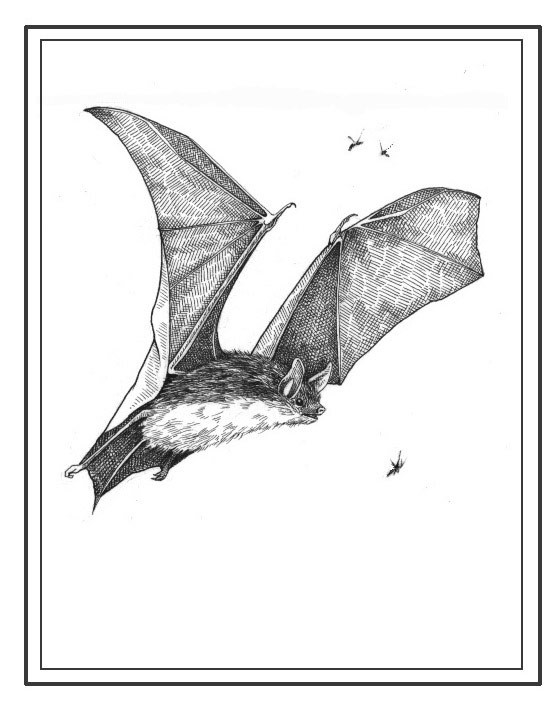
A small brown object dropped as I swung open the door to our garage loft. Before I could process what I had glimpsed, the thing unfurled black, umbrella-like wings, swooped to the wall and clung there. I had disturbed a bat that was roosting in the crack between door and frame. I was happy to see it. After all the chilling news about the decimation of bats by the disease called white nose syndrome, it was encouraging to see this survivor.
Before white nose syndrome I had grown quite accustomed to seeing bats flitting around in Thetford, Vt., where we live. We often saw them near the Army Corps of Engineers flood-control dam on the Ompompanoosuc River, not far from the Connecticut River. Several years before the disease struck, Gary Pelton, a natural resources manager for the Army Corps, conducted surveys of bat populations within the flood-control area, trapping the creatures in fine-mesh ‘mist nets’ that were strung volleyball-style across regular flight routes. At the time, he and his colleagues found northern long-eared bats, little brown myotis and even one rare small-footed bat. Bats eat insects, more than 1,000 a night, so they like to forage along the fringes of woodlands, around water bodies, like the Ompompanoosuc.
Some people seek to eliminate bats out of phobia, or when they find them roosting and depositing guano in attic or barn. But consider the bat’s marvelous abilities: With eyesight no better than a mouse’s, a bat can fly, and chase and catch insects on the wing. It performs this incredible feat thanks to a superb ability to sense objects with by a system of squeaks and echoes, known as echolocation.
Bats’ echolocation squeaks are undetectable to humans. The squeaks are very short in duration—from one-tenth of a second to as little as one five-thousandth of a second. The durations are short because bats must hear the echo of each squeak before emitting another. The time it takes for the sound to bounce back to the bat’s ears from a nearby object, such as an insect, tells the bat how far away the object is. However, bats can only process one echo at a time.
With an interval of one-tenth of a second between squeaks, a bat can detect an object up to 50 feet away, because it takes sound waves about one tenth of a second to travel 100 feet (there and back.) They use this low rate of calling during their general search for insects. But once they start closing in on prey, they begin squeaking faster and faster, up to 200 times per second.
Bat echolocation involves more than just simple squeaks and listening for echoes. Sometimes they will emit a ‘broadband’ squeak that starts at a high pitch and ends with a lower one, like a singer going down through an octave. This enables better discrimination of the time delay between call and echo. Astonishingly, experiments show that bats using broadband squeaking can distinguish between two targets half a millimeter apart.
When bats choose to squeak in a monotone, they can tell which way an insect is going. The movement of the insect causes the echo to be distorted, so it appears higher in pitch for an approaching insect and lower if the insect is moving away (an effect known as the ‘Doppler shift.’)
Bats don’t always squeak when flying. Their eyesight works well enough for a commute to hunting grounds. And that helps explains why Pelton was able to trap them with his nearly invisible nets. Had they been squeaking, they likely would have avoided the net.
Bats also seem to have phenomenal memories. They apparently remember not only local routes but also migration routes that can go for hundreds of miles. Pelton, who operates out of the Army Corps offices in Perkinsville, Vt., noted that after bats had been caught in his nets, then released, they would squeak the next time they traveled that route. It would seem they remembered where they had been trapped.
Bats have remarkable flying skills. Thanks to their webbed and highly flexible wings (unlike birds’ wings, which are stiff), they have remarkable maneuverability in air, including the ability to make tight 180-degree turns in mid-flight.
Sadly, white nose syndrome has caused near total mortality of several important bat colonies in our region, including the one near our home: the Elizabeth Mine in Strafford. Once one of the country’s premier copper mines, the abandoned facility still has open ventilation shafts and underground spaces that not long ago sheltered an estimated 1,000 resident bats. It was a place for winter hibernation for countless others. Biologists now think that the damp, cold atmosphere of mines and caves fosters the growth of a cold-loving fungus that is the source of white nose syndrome.
I wonder about the fate of the little bat in the garage. Will it be there next year?

